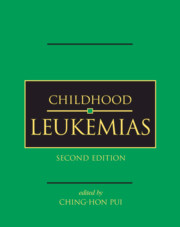Book contents
- Frontmatter
- Contents
- List of contributors
- Preface
- Part I History and general issues
- Part II Cell biology and pathobiology
- Part III Evaluation and treatment
- 14 Pharmacokinetic, pharmacodynamic, and pharmacogenetic considerations
- 15 Assays and molecular determinants of cellular drug resistance
- 16 Acute lymphoblastic leukemia
- 17 Relapsed acute lymphoblastic leukemia
- 18 B-cell acute lymphoblastic leukemia and Burkitt lymphoma
- 19 Acute myeloid leukemia
- 20 Relapsed acute myeloid leukemia
- 21 Myelodysplastic syndrome
- 22 Chronic myeloproliferative disorders
- 23 Hematopoietic stem cell transplantation
- 24 Acute leukemia in countries with limited resources
- 25 Antibody-targeted therapy
- 26 Adoptive cellular immunotherapy
- 27 Gene transfer: methods and applications
- 28 Minimal residual disease
- Part IV Complications and supportive care
- Index
- Plate Section between pages 400 and 401
- References
15 - Assays and molecular determinants of cellular drug resistance
from Part III - Evaluation and treatment
Published online by Cambridge University Press: 01 July 2010
- Frontmatter
- Contents
- List of contributors
- Preface
- Part I History and general issues
- Part II Cell biology and pathobiology
- Part III Evaluation and treatment
- 14 Pharmacokinetic, pharmacodynamic, and pharmacogenetic considerations
- 15 Assays and molecular determinants of cellular drug resistance
- 16 Acute lymphoblastic leukemia
- 17 Relapsed acute lymphoblastic leukemia
- 18 B-cell acute lymphoblastic leukemia and Burkitt lymphoma
- 19 Acute myeloid leukemia
- 20 Relapsed acute myeloid leukemia
- 21 Myelodysplastic syndrome
- 22 Chronic myeloproliferative disorders
- 23 Hematopoietic stem cell transplantation
- 24 Acute leukemia in countries with limited resources
- 25 Antibody-targeted therapy
- 26 Adoptive cellular immunotherapy
- 27 Gene transfer: methods and applications
- 28 Minimal residual disease
- Part IV Complications and supportive care
- Index
- Plate Section between pages 400 and 401
- References
Summary
Introduction
Chemotherapy for children with acute leukemia has improved impressively over the past 40 years, despite the use of similar agents throughout this period. The efficacy of antileukemic drugs depends largely on their dosages and schedules of administration. It also depends on the intrinsic and acquired resistance of leukemic cells to drug treatment. Knowledge of the factors contributing to cellular drug resistance was slow to accumulate, but has grown rapidly over the last two decades. This chapter describes some of the prominent methods for assessing drug resistance in leukemia patients and reviews progress in elucidating the molecular determinants of this phenomenon.
Drug cytotoxicity assays
In the early 1980s, drug cytotoxicity was mainly evaluated by clonogenic assays such as colony-forming unit assays and stromal cell layer-supported long-term marrow cultures. These time-consuming assays rely on the in vitro proliferating capacity of cells, a characteristic that in practice is restricted to acute and chronic myeloid blasts. The most frequent type of leukemia in children, acute lymphoblastic leukemia (ALL), cannot be tested with assays of this type because the cells lack any in vitro proliferating capacity. Moreover, the resistance of resting, nondividing cells, which may be an important source of treatment failure, is not detectable with these proliferation-based assays.
Dye exclusion or differential staining cytotoxicity assay
In 1983, Weisenthal and co-workers introduced the dye exclusion assay (DEA), which enables one to test the cytotoxicity of drugs in nonclonogenic cells. This assay exploits trypan-blue dye, which selectively diffuses into damaged cells with permeabilized cell membranes.
- Type
- Chapter
- Information
- Childhood Leukemias , pp. 414 - 438Publisher: Cambridge University PressPrint publication year: 2006



